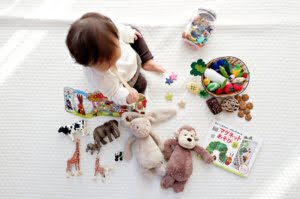Think back to your childhood, what are some of your most fond memories? Did they involve sitting at a desk in school, doing homework, or completing your chores? Likely not.
 What they probably do include are going to a theme park, playing in your backyard, being at the park, or hanging around your peers and playing fun games. That is because these activities are fun. Playing is fun. Play is how we learn. Play is what we remember. Play is the way in which we grow.
What they probably do include are going to a theme park, playing in your backyard, being at the park, or hanging around your peers and playing fun games. That is because these activities are fun. Playing is fun. Play is how we learn. Play is what we remember. Play is the way in which we grow.
In today’s culture, children are being asked to grow up at a rapid rate. In fact, one article by BBC news claims, “modern childhood ends at age 12,” (Coughlan, 2013). Furthermore, the average age of a child receiving a cell phone is 10 years old (Watkins, 2018).
It seems that in the chaos of this ever changing world coupled with the advances of modern technology, we have forgotten what it is children really need. Kay Redfield Jamison said it best, “Children need the freedom and time to play.
Play is not a luxury. Play is a necessity.” Play is an integral part of learning not only about the world around you but who you are in this world. Play has the power to teach children how to thrive in this world and can be the missing ingredient for success in childhood.
What is play therapy?
Play therapy is a therapeutic approach utilized for children whose developmental age is 3-12 years old. Play therapy allows children to express their emotions simply through the use of toys, games, art, and/or music. Therapeutic play typically occurs in a safe and comfortable playroom designed to meet each child’s specific needs.
Goals of play therapy
The overarching goal of play therapy is to teach children how to express themselves in healthier ways, follow directions and take responsibility for their actions, and increase their feelings of control. These goals are described further below.
Increase healthy expression, both verbally and non-verbally
 Children use play as their primary mode of communication. So often we lean solely on children’s verbal communication to understand what the child needs and wants to tell us. However, if you take a step back and just observe your child, you will see just how much they communicate to you through their play.
Children use play as their primary mode of communication. So often we lean solely on children’s verbal communication to understand what the child needs and wants to tell us. However, if you take a step back and just observe your child, you will see just how much they communicate to you through their play.
Playing uninterrupted allows children to build their vocabulary and show you what it is they are needing. Therapeutic play allows children to have a safe outlet of expression which in turn alters the way they express themselves outside of the play room.
Following directions and taking responsibility for their actions
Play therapists are trained to watch for cues in play and reflect feelings and actions being expressed. This allows the child to see how certain feelings or actions may be impacting others around them as well as themselves. Preparing a child to be accountable for their own feelings and actions is always a goal for parents and therapists alike.
Increase feelings of control
As a child, almost everything you do is out of your control. From the moment you wake up, until the moment you go to sleep you are told what to do by adults. Allowing children to process their own emotions at their own pace increases feelings of control over certain situations.
Play allows children to reenact whatever it is that has them “stuck.” The play therapist’s job is to then reframe this play in order to provide the child with positive insight to their unique situation.
Why play therapy?
Play therapy can be used for a spectrum of issues in childhood, whether they are social or emotional, or both. The following are a few examples of when play therapy may be helpful.
- Psycho-social issues such as anxiety, depression, anger, grief, stress, lack of communication, and/or loss
- Behavioral problems such as aggression towards self or others, ADHD, and/or non-compliance towards others
- Responses to family and relationship problems such as parental separation, attachment disorders, and/or loss of a parent
- Educational issues such as decreased organizational skills, difficulty planning, and/or difficulty with executing basic tasks
- Trauma such as hospitalization, serious illness, domestic violence, abuse, and/or neglect
What to expect
 The play therapist will first conduct an initial interview with the parent(s), and then another with both the parent(s) and the child. These intake interviews will be used to gather information about the family dynamics, the identified problem, and potential goals for therapy.
The play therapist will first conduct an initial interview with the parent(s), and then another with both the parent(s) and the child. These intake interviews will be used to gather information about the family dynamics, the identified problem, and potential goals for therapy.
Once this assessment is completed, goals will be set with the family and the child will begin to see the play therapist weekly for 30-45 minutes (dependent on the child’s developmental level). Each week, an update will be given to the parents based on session progress and predetermined goals. Parents are also expected to report back any and all progress during the week.
Conclusion
Mr. Rodgers stated it perfectly, “play is often talked about as if it were a relief from serious learning. But for children, play is serious learning.”
When thinking about seeking therapeutic support for your child, the decision can seem insurmountable but know that there are options. Therapeutic play is a less invasive way to allow children the freedom to express themselves to someone else. As stated at the beginning of this article, children are overwhelmed with the thought of growing up too fast.
Today’s culture promotes un-Biblical principles that create hardships for children and families. If you or your child is struggling, a Christian based play therapist can help both you and your child(ren) get back on track. In the meantime, I have outlined some tips you can use to increase positive play and interactions with your child(ren) at home.
Tips for playing with your children at home
 One sub-branch of play therapy is called Parent-Child Interaction Therapy. This type of therapy is offered to parents and children and includes one-on-one coaching and guidance from a therapist. During this time, many parenting skills are taught to parents, one of these being PRIDE skills. These skills are outlined below and can provide you with a starting point for playing with your child at home.
One sub-branch of play therapy is called Parent-Child Interaction Therapy. This type of therapy is offered to parents and children and includes one-on-one coaching and guidance from a therapist. During this time, many parenting skills are taught to parents, one of these being PRIDE skills. These skills are outlined below and can provide you with a starting point for playing with your child at home.
Praise
Provide your child with very specific praises about behaviors you want to see more of. For example, “I really liked how you cleaned up so quickly,” or “thank you for being so gentle when handing me that toy.” Praise increases positive behaviors and has the power to decrease negative behaviors simply by highlighting the opposite.
Reflect back appropriate speech
For example, if your child says, “look I built a tower,” you would respond, “yes you built a tower.” Reflections show your child you are genuinely interested in what it is they are doing.
Imitate your child
This one is simple. Do what your child is doing. “I see you are drawing a house, I am going to draw a house just like you.” Or, “building that tower looks so fun, I want to make one just like yours.” Not only will this show your child you are interested in how they are playing, but it will also provide them with feelings of pride in whatever it is they are doing.
Describe what you see
Have you ever watched a game of football or baseball? They both have something in common; there are announcers describing what is happening at any given moment. This is your job. Be the commentator of your child’s play. “I see you are placing the red block on the blue block, and now you are picking up the green block.”
Enjoy your time
Have fun. Nothing is better for a child than having their parent(s) on the floor playing with them and having fun. It doesn’t have to be fancy or full of expensive toys, children just need you. Be present and enjoy it.
The laundry, cleaning, and anything else on your to do list can wait. It only takes five minutes a day of playing with your child to see increases in positive interactions and behaviors. Virginia Axline once stated, “enter into a child’s play and you will find the place where their minds, hearts, and souls meet.”
References:
Coughlan, S. (2013, March 6). Modern childhood ‘ends at age of 12’. Retrieved January 1, 2020, from https://www.bbc.com/news/education-21670962.Watkins, C. (2018, March 6). Are kids today growing up too fast? Retrieved January 1, 2020, from http://themodernsaint.com/are-kids-today-growing-up-too-fast/.
Photos:
“Doing the Wash”, Courtesy of Andrea Tummons, Unsplash.com, CC0 License; “Playtime!”, Courtesy of Robert Collins, Unsplash.com, CC0 License; “Which Toy to Choose?”, Courtesy of Shitota Yuri, Unsplash.com, CC0 License; “Praying”, Courtesy of David Beale, Unsplash.com, CC0 License



